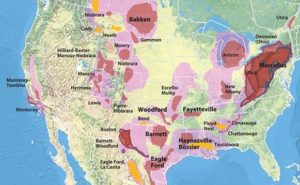by Andy May, November 13, 2018 in WUWT
Popular accounts of shale oil and gas reservoirs are often riddled with errors and, even when technically correct, often misleading. As a shale petrophysicist, retired from Devon Energy, I thought I would try and explain, in a non-technical way, how these reservoirs work and why they have been so successful.
…

Figure 1. Major shale oil and gas plays in the United States. Source EIA.
by David Middleton, November 13, 2018 in WUWT
This story was previously discussed here at WUWT… But, why wasn’t this headline news in the Washington Post, New York Times, etc.? Yes… That was a rhetorical question.
…
Comparisons with nearby automated weather stations suggest that air temperatures during these events are near −94 ± 4 °C or about −138 F. Ultracold conditions (below −90 °C) occur more frequently when the Antarctic polar vortex is strong. This temperature appears to be about as low as it is possible to reach, even under clear skies and very dry conditions, because heat radiating from the cold clear air is nearly equal to the heat radiating from the bitterly cold snow surface.
…
by U. of California – Santa Barbara, Nov 13, 2018 in ScienceDaily
-
As an indicator of the impacts of climate change, Arctic sea ice is hard to beat. Scientists have observed the frozen polar ocean advance and retreat at this most sensitive region of the Earth over decades for insight on the potential ripple effects on assorted natural systems: global ocean circulation, surrounding habitats and ecosystems, food sources, sea levels and more.
-
…
-
“We’re mostly interested in the period from the early 2000s to the present day, where we see such strong melting,” said graduate student Ian Baxter, who also works with Ding. It’s known, he added, that the effects of changes in the Arctic are no longer confined to the region and in fact spread to the mid-latitudes — often in the form of cold weather outbreaks. The group is interested in how effects in the tropics could spread beyond that region and affect the Arctic.
La géologie, une science plus que passionnante … et diverse

